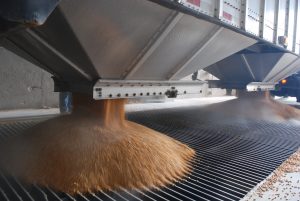
All industries need reliable material flow to maintain productivity and product integrity. Any material blocks–like settling of powders in storage, or material bridging in a hopper–cause delays and extra costs.
Unfortunately, most bulk materials will not flow properly without some kind of intervention. This complete guide to flow aids will tackle:
- What is a flow aid, and how does it improve plant operations
- The different kinds of flow aids, and their pros and cons
- What to consider when choosing a flow aid for your material and process
What are flow aids?
Flow aids are mechanisms or devices that encourage the efficient movement of materials inside a container or vessel. They prevent flow issues, such as:
- Sluggish flow. Some bulk solids like mined materials or liquid cheese will flow slowly because of their density or the tendency to interlock or cling to vessel walls. Flow aids activate the material and flush it out of the vessel.
- Material bridging in the hopper. Bridging, arching, or ratholing is a phenomenon where material forms an arch over the hopper outlet, thus obstructing the flow. Flow aids break up the bridges and prevent them from forming.
- Segregation. Mixes made of materials with different shapes, densities, or other physical or chemical properties can segregate during storage or even during processing. Flow aids can activate the material so that the flow (and the proportion of ingredients) remains constant.
What are the different kinds of flow aids?
There are three types of flow aids: mechanical, fluidizing systems, and chemical. Each has its pros and cons.
Mechanical flow aids use agitation or physical force to break up material blocks. Examples include vibrators, air knockers, paddle mixers, and agitators. Mechanical flow aids are relatively inexpensive and easy to source, they’re not appropriate for some vessels or materials.
Mechanical agitation causes metal fatigue, which can damage vessels–especially small vessels with thin walls. It can also make some materials more compact or cause heavier particles to settle. This can worsen material bridging in hopper or material segregation.
Fluidizing systems use air pulses to push material and break up cohesive friction. Examples include fluidizers, air pads, air cannons, and AirSweep.
While all of these use the principle of aeration, they are very different in terms of capability and operating cost.
Fluidizers and air pads use a combination of aeration and gentle vibration. These work on light powders like flour, but will not be effective for sticky, heavy, or moist materials.
Air cannons release more powerful blasts of air, but require more electricity and air to operate. They’re also big, bulky, and produce a lot of “kickback” so they may not be used on some types of process equipment.
Among all the fluidizing systems, AirSweep is the best combination of performance, cost, and flexibility. It releases powerful, controlled air pulses that activate all types of material without damaging vessel walls. The compact nozzle can be installed on any vessel, including silos, hoppers, chutes, pipes, ribbon blenders, or any place where material tends to hang up.
Chemical flow aids change the material properties to material bridging in hoppers. For example, silicone-based agents like magnesium stearate can promote free flow, while anti-caking agents like calcium silicate can prevent lumps and caking.
While chemical flow aids can improve a material’s flow, they can’t break up material bridging in the hopper. Other flow aids must still be installed on the vessel itself to fix material blocks.
Questions to ask when choosing a flow aid
Like any other equipment investment, you need to consider different factors to find the best solution for your needs. Here is a checklist of key questions to ask while reviewing your options.
Material properties
- What materials have poor flow properties?
- What are the material’s other properties (density, cohesion, particle size, etc)
- How do they respond to moisture? Do they become wet or sticky?
- Do they tend to clump or settle during storage?
- How do they respond to vibration or aeration?
- Do any of the materials need sanitary handling to prevent spoilage or contamination?
Vessel characteristics
- What type of vessel do you have?
- What is the size of the vessel?
- Where is the vessel located?
- Where does the bridging or material flow problem usually occur?
- Do you have blind spots that are hard to reach?
Flow aid features
- What kind of materials can it activate?
- What is the activation radius?
- How much energy and air does it consume?
- Does it damage the vessel?
- Is it difficult to install? How long will installation take?
- Is it safe to use in hazardous environments?
- How often do I need to replace parts?
- How long will it take to receive replacement parts?
- Does it offer a warranty?
Worker experience
- Can it automate material flow, or will workers still need to monitor and manually clear material blocks and residue?
- How easy is it to clean and maintain the flow aid?
- Does it produce a lot of noise?
How to find the flow aid with the highest ROI
The right flow aid can solve material bridging in hoppers and other vessels and improve productivity and cost-efficiency. However, the wrong flow aid can actually increase delays and costs.
Learn more about how AirSweep can solve material flow problems and give the highest return on investment. You can watch this video or contact our sales team for a personalized consultation.





Comments are closed